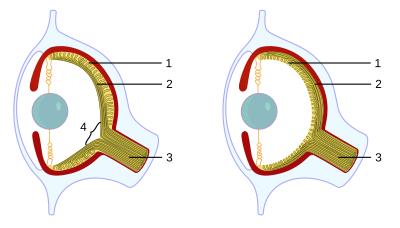Blind spot (vision): Difference between revisions
ClueBot NG (talk | contribs) m Reverting possible vandalism by 216.52.207.104 to version by Kramer Associates. False positive? Report it. Thanks, ClueBot NG. (707633) (Bot) |
No edit summary Tag: repeating characters |
||
| Line 8: | Line 8: | ||
A '''blind spot''', also known as a [[scotoma]], is an obscuration of the [[visual field]]. A particular blind spot known as the blindspot, or ''physiological blind spot'', or ''punctum caecum'' in medical literature, is the place in the visual field that corresponds to the lack of light-detecting [[photoreceptor cell]]s on the [[optic disc]] of the [[retina]] where the [[optic nerve]] passes through it.<ref name="Gregory&11Scholarpedia"> Gregory, R., & Cavanagh, P. (2011). [http://www.scholarpedia.org/article/The_Blind_Spot "The Blind Spot"]. [[Scholarpedia]]. Retrieved on 2011-05-21.</ref> Since there are no cells to detect light on the optic disc, a part of the field of vision is not perceived. The [[human brain|brain]] fills in with surrounding detail and with information from the other [[human eye|eye]], so the blind spot is not normally perceived. |
A '''blind spot''', also known as a [[scotoma]], is an obscuration of the [[visual field]]. A particular blind spot known as the blindspot, or ''physiological blind spot'', or ''punctum caecum'' in medical literature, is the place in the visual field that corresponds to the lack of light-detecting [[photoreceptor cell]]s on the [[optic disc]] of the [[retina]] where the [[optic nerve]] passes through it.<ref name="Gregory&11Scholarpedia"> Gregory, R., & Cavanagh, P. (2011). [http://www.scholarpedia.org/article/The_Blind_Spot "The Blind Spot"]. [[Scholarpedia]]. Retrieved on 2011-05-21.</ref> Since there are no cells to detect light on the optic disc, a part of the field of vision is not perceived. The [[human brain|brain]] fills in with surrounding detail and with information from the other [[human eye|eye]], so the blind spot is not normally perceived. |
||
Although all [[vertebrate]]s have this blind spot, [[cephalopod eye]]s, which are only superficially similar, do not. In them, the optic nerve approaches the receptors from behind, so it does not create a break in the retina. |
Although all [[vertebrate]]s have this blind spot, [[cephalopod eye]]s, which are only superficially similar, do not. In them, the optic nerve approaches the receptors from behind, so it does not create a break in the retina this is gayyyyyyyyyyyyyyyyyyy <3. |
||
The first documented observation of the phenomenon was in the 1660s by [[Edme Mariotte]] in France. At the time it was generally thought that the point at which the optic nerve entered the eye should actually be the most sensitive portion of the retina; however, Mariotte's discovery disproved this theory. |
The first documented observation of the phenomenon was in the 1660s by [[Edme Mariotte]] in France. At the time it was generally thought that the point at which the optic nerve entered the eye should actually be the most sensitive portion of the retina; however, Mariotte's discovery disproved this theory. |
||
Revision as of 14:50, 7 November 2011
A blind spot, also known as a scotoma, is an obscuration of the visual field. A particular blind spot known as the blindspot, or physiological blind spot, or punctum caecum in medical literature, is the place in the visual field that corresponds to the lack of light-detecting photoreceptor cells on the optic disc of the retina where the optic nerve passes through it.[1] Since there are no cells to detect light on the optic disc, a part of the field of vision is not perceived. The brain fills in with surrounding detail and with information from the other eye, so the blind spot is not normally perceived.
Although all vertebrates have this blind spot, cephalopod eyes, which are only superficially similar, do not. In them, the optic nerve approaches the receptors from behind, so it does not create a break in the retina this is gayyyyyyyyyyyyyyyyyyy <3.
The first documented observation of the phenomenon was in the 1660s by Edme Mariotte in France. At the time it was generally thought that the point at which the optic nerve entered the eye should actually be the most sensitive portion of the retina; however, Mariotte's discovery disproved this theory.
The blind spot is located about 12–15° temporal and 1.5° below the horizontal and is roughly 7.5° high and 5.5° wide.[2]
Blind spot test
| Template:Highlight1 colspan="5" style="border:solid 1px #AAAAAA; " | Demonstration of the blind spot | ||||
|---|---|---|---|---|
| O | X | |||
| colspan="5" Template:Highlight2 style="border:solid 1px #AAAAAA;" | Instructions: Your face should be a few fingers away from the screen. Close the right eye and focus the left eye on the X. Now move away from the screen slowly, and at one point the O will disappear. This will happen approx. when the screen is about 25cm away (3x the width of this diagram). As you move further away, the O will reappear. If you close your left eye and look at the O, the X will disappear over a similar range. | ||||
See also
References
- ^ Gregory, R., & Cavanagh, P. (2011). "The Blind Spot". Scholarpedia. Retrieved on 2011-05-21.
- ^ MIL-STD-1472F, Military Standard, Human Engineering, Design Criteria For Military Systems, Equipment, And Facilities (23 Aug 1999) PDF

